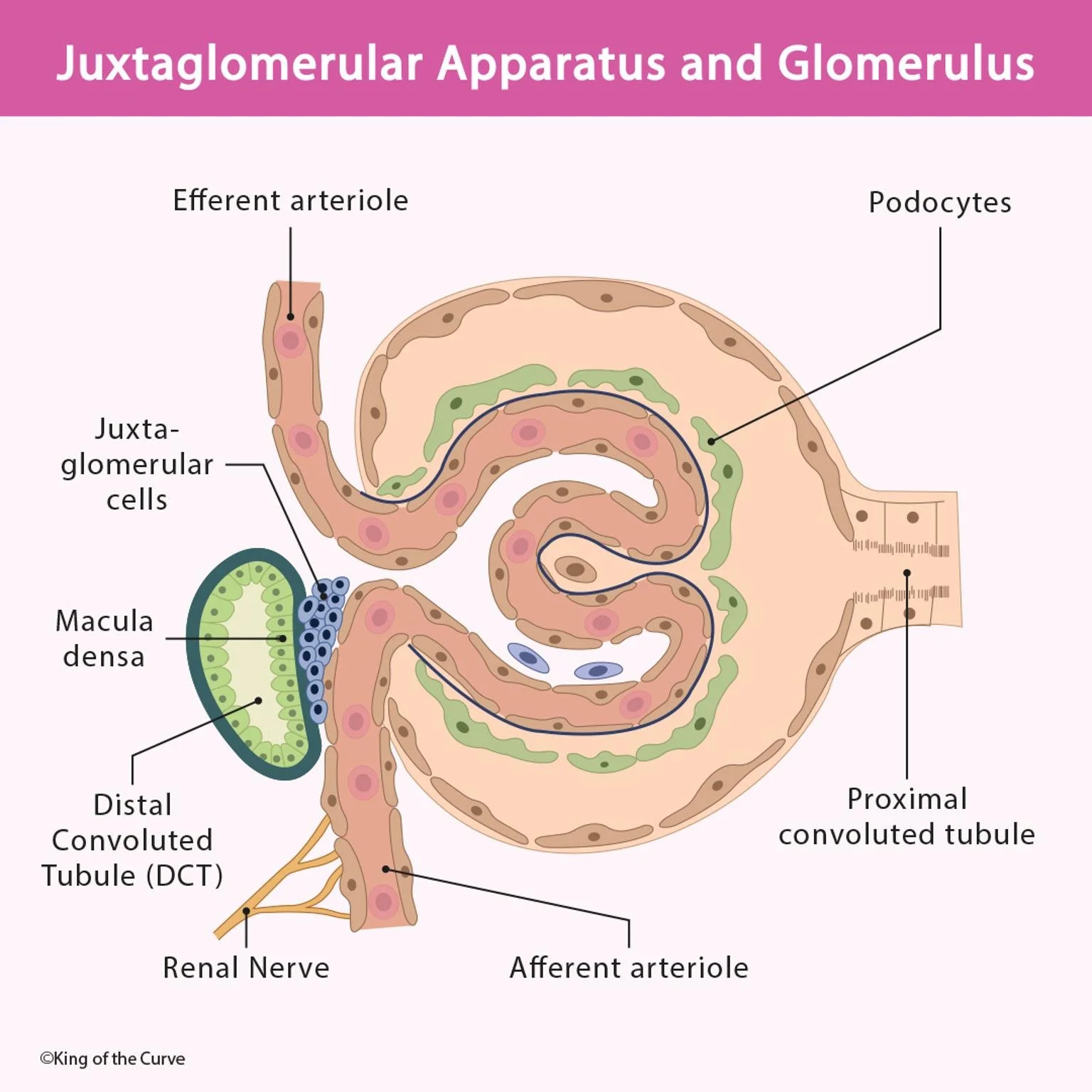🧠 Juxtaglomerular Apparatus and Glomerulus: The Kidney’s Regulation Hub
The juxtaglomerular apparatus (JGA) is a specialized structure located where the distal convoluted tubule (DCT) comes into contact with the afferent arteriole of the same nephron. Its main function is to regulate blood pressure and the glomerular filtration rate (GFR) — the process by which the kidneys filter blood to form urine.
⚙️ Structure and Components
The JGA consists of three key components:
Juxtaglomerular (JG) Cells: Found in the wall of the afferent arteriole, these modified smooth muscle cells secrete renin, an enzyme crucial for the activation of the renin-angiotensin-aldosterone system (RAAS).
Macula Densa: Specialized epithelial cells of the distal convoluted tubule that sense sodium chloride (NaCl) concentration in the filtrate.
Extraglomerular Mesangial Cells (Lacis Cells): These cells act as mediators, facilitating communication between the macula densa and the JG cells.
Together, these components form a feedback system that helps the kidney regulate GFR and maintain hemodynamic stability.
🔄 Functional Mechanism
When blood pressure drops or sodium levels are low, the macula densa signals the JG cells to release renin.
Renin then acts on angiotensinogen (produced by the liver) to form angiotensin I, which is converted to angiotensin II by ACE (angiotensin-converting enzyme).
Angiotensin II constricts blood vessels and stimulates aldosterone secretion from the adrenal glands, leading to sodium and water retention — effectively restoring blood pressure and blood volume.
🩺 Clinical Relevance
The JGA plays a pivotal role in disorders related to blood pressure regulation and kidney function:
| Condition | Effect on JGA Function | Key Notes |
|---|---|---|
| Renal Artery Stenosis | Increased renin secretion due to low renal perfusion | Causes secondary hypertension |
| Chronic Kidney Disease (CKD) | Impaired renin release and tubular signaling | Leads to dysregulated blood pressure |
| Hypertension | Persistent overactivation of the JGA and RAAS | Results in elevated systemic pressure |
💡 Summary
The juxtaglomerular apparatus is a vital regulator that connects renal filtration, blood pressure control, and hormonal signaling. By integrating structural and biochemical cues, it ensures the kidneys maintain systemic equilibrium — highlighting the elegance and precision of human physiology.
🚀 Call to Action
Want to master renal physiology for your next exam or clinical rotation? 🩺
Explore more visual breakdowns and high-yield study tools on King of the Curve, where complex concepts like the JGA, nephron function, and RAAS are made simple and memorable.
👉 Visit King of the Curve to level up your learning today!
Frequently Asked Questions (FAQs)
-
Aim for 4-6 focused hours, ensuring you incorporate breaks to avoid burnout.
-
Practice mindfulness techniques, take practice exams under realistic conditions, and maintain a balanced lifestyle.
-
Set short-term goals, seek support from mentors, and reward yourself for small achievements.
-
Regular exercise improves focus, reduces stress, and enhances overall mental clarity.
-
KOTC offers personalized learning tools, gamification features, and adaptive question banks to help students stay on track without burnout.


